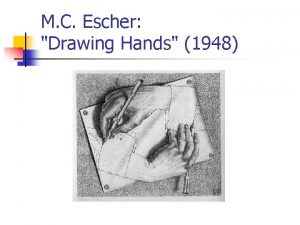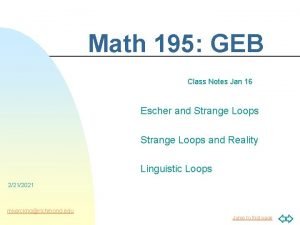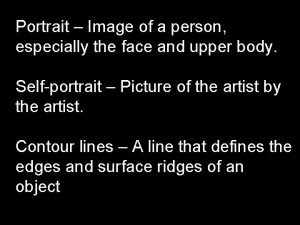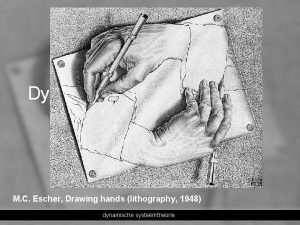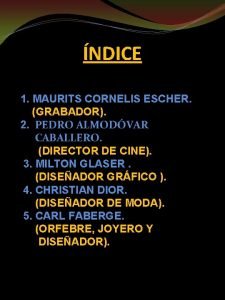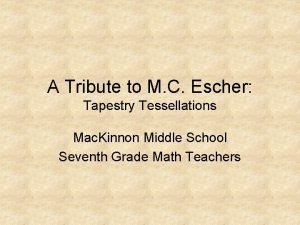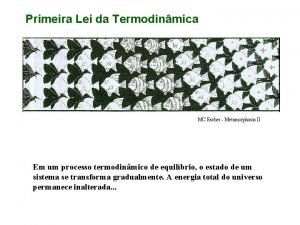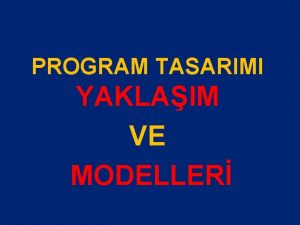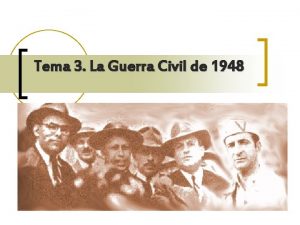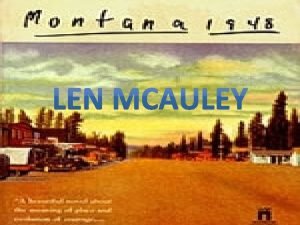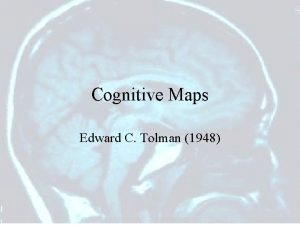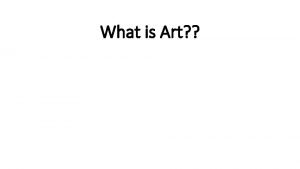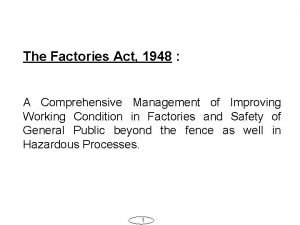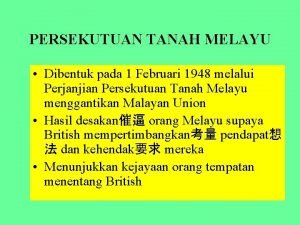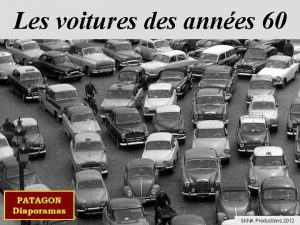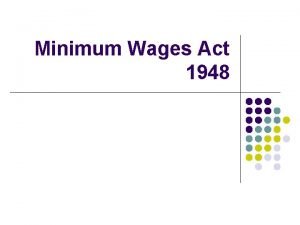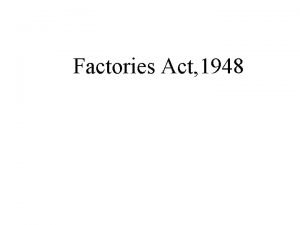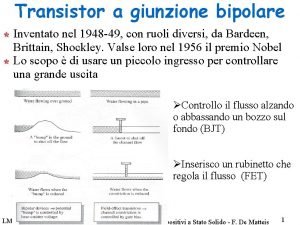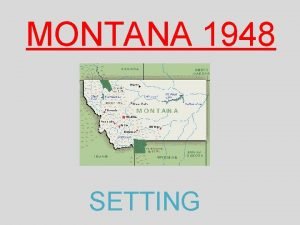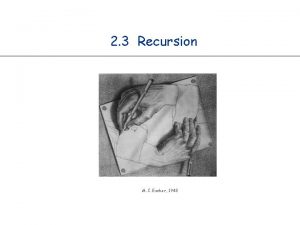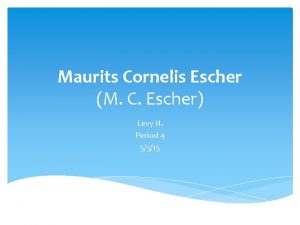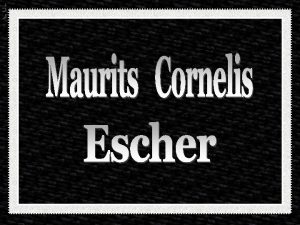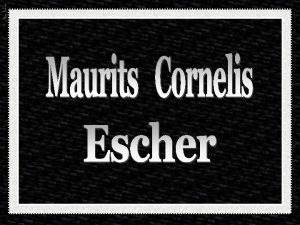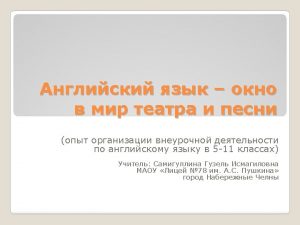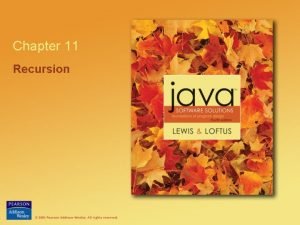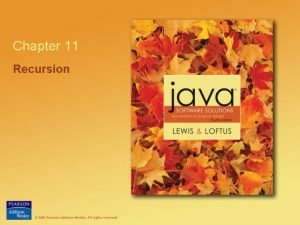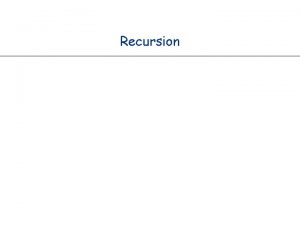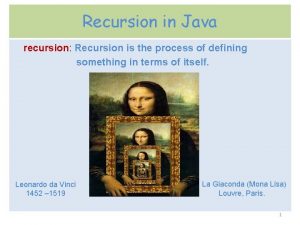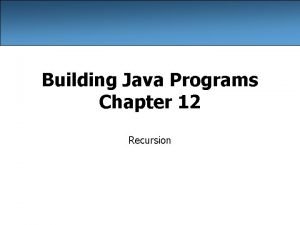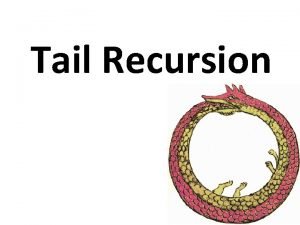M C Escher Drawing Hands 1948 Recursion Dave


































































- Slides: 66

M. C. Escher: "Drawing Hands" (1948)

Recursion Dave Feinberg

Computation n n All computation consists of chugging along from state to state. . . There is a set of rules that tell us, given the current state, which state to go to next.

Arithmetic as Rewrite Rules n 2+3+4 5+4 9 n We stop when we reach a number. n n

Functions as New Rules def square(n): return n * n When we see: square(something) Rewrite it as: something * something

Functions as Rewrite Rules def square(n): return n * n n square(3) 3*3 9

Piecewise Functions f(n) = 1 n-1 f(4) 4 -1 3 if n = 1 if n > 1

In Python def f(n): if n == 1: return 1 else: return n - 1

This is just math, right? n n Difference between mathematical functions and computation functions. Computation functions must be effective. For example, we can define the square-root function as √x = the y such that y ≥ 0 and y² = x n This defines a valid mathematical function, but it doesn't tell us how to compute the square root of a given number.

Fancier Functions def f(n): return n + (n - 1) Find f(4)

Fancier Functions def f(n): return n + (n - 1) def g(n): return n + f(n - 1) Find g(4)

Fancier Functions def f(n): return n + (n - 1) def g(n): return n + f(n - 1) def h(n): return n + h(n - 1) Find h(4)

Recursion def h(n): return n + h(n - 1) n h is a recursive function, because it is defined in terms of itself.

Definition Recursion n See: "Recursion".

Recursion def h(n): return n + h(n - 1) h(4) 4 + h(3) 4 + 3 + h(2) 4 + 3 + 2 + h(1) 4 + 3 + 2 + 1 + h(0) 4 + 3 + 2 + 1 + 0 + h(-1) 4 + 3 + 2 + 1 + 0 + -1 + h(-2). . . Evaluating h leads to an infinite loop!

What you are thinking "Ok, recursion is bad. What's the big deal? "

Recursion def f(n): if n == 1: return 1 else: return f(n - 1) Find f(1) f(2) f(3) f(100)

Recursion def f(n): if n == 1: return 1 else: return f(n - 1) f(3 - 1) f(2 - 1) f(1) 1

Terminology def f(n): if n == 1: return 1 else: return f(n - 1) base case recursive case "Useful" recursive functions have: n at least one recursive case n at least one base case so that the computation terminates

Recursion def f(n): if n == 1: return 1 else: return f(n + 1) Find f(5) We have a base case and a recursive case. What's wrong?

Recursion The recursive case should call the function on a simpler input, bringing us closer and closer to the base case.

Recursion def f(n): if n == 0: return 0 else: return 1 + f(n - 1) Find f(0) f(1) f(2) f(100)

Recursion def f(n): if n == 0: return 0 else: return 1 + f(n - 1) f(3) 1 + f(2) 1 + f(1) 1 + 1 + f(0) 1+1+1+0 3

Factorial n 4! = 4 × 3 × 2 × 1 = 24

Factorial n Does anyone know the value of 9! n 362, 880 n Does anyone know the value of 10! n How did you know?

Factorial n 9! = 9× 8× 7× 6× 5× 4× 3× 2× 1 n 10! = 10 × 9! n n! = n × (n - 1)! n That's a recursive definition!

Factorial def fact(n): return n * fact(n - 1) fact(3) 3 × fact(2) 3 × 2 × fact(1) 3 × 2 × 1 × fact(0) 3 × 2 × 1 × 0 × fact(-1). . .

Factorial n What did we do wrong? n What is the base case for factorial?

Factorial n! = # of ways to seat n people in a room with n chairs. How many ways are there to seat 3 people in a room with 3 chairs?

Factorial There are 3! = 3 × 2 × 1 = 6 ways to seat 3 people in a room with 3 chairs. A B C A C B B A C B C A B C B A

Factorial There are 2! = 2 × 1 = 2 ways to seat 2 people in a room with 2 chairs. A B B A

Factorial There is only 1! = 1 way to seat 1 person in a room with 1 chair. A How many ways are there to seat 0 people in a room with 0 chairs?

Factorial There is 1 way to seat 0 people in a room with 0 chairs. This is why 0! is defined to be 1. That's our base case!

Factorial def fact(n): if n == 0: return 1 else: return n * fact(n - 1) fact(3) 3 × fact(2) 3 × 2 × fact(1) 3 × 2 × 1 × fact(0) 3× 2× 1× 1 6

Writing Recursive Functions n n Write if. Why? Base case: Test for and handle simplest case. Recursive case: Call function on simpler input. Assume the recursive call works. How does it help us?

Honey Bees Drone: son of queen Queen: daughter of queen + drone (Worker: daughter of queen + drone)

Honey Bees 1. 2. 3. 4. D Q QD QDQ Rewrite rules: individual parent grandparents great grandparents D→Q Q → QD

Honey Bees 1. D individual 2. Q parent 3. QD grandparents 4. QDQ great grandparents 5. QDQQD 6. QDQQDQDQ 7. QDQQDQQD How many in each generation?

Honey Bees 1. 2. 3. 4. 5. 6. 7. It's D Q QD QDQQDQDQQDQQD the Fibonacci sequence! 1 1 2 3 5 8 13

Fibonacci In the Fibonacci sequence, each term = sum of previous 2 terms Let fib(n) be the nth term. Then, fib(n) = fib(n - 1) + fib(n - 2) The sequence is defined recursively!

Fibonacci def fib(n): return fib(n - 1) + fib(n - 2) Find fib(1) We need a base case!

Fibonacci def fib(n): if n == 1: return 1 else: return fib(n - 1) + fib(n - 2) Find fib(1) Find fib(2) How do we fix our function?

Fibonacci def fib(n): if n <= 2: return 1 else: return fib(n - 1) + fib(n - 2) Find fib(1) Find fib(2) Find fib(3)

Tiling Squares Rewrite rule: Add square to long side.

Tiling Squares What is the side length of each square?

Tiling Squares 5 8 3 1 1 2 21 13

Spiral

Fibonacci 1 2 3 5 8 13 21 34 ÷ ÷ ÷ ÷ 1 = 2 = 3 = 5 = 8 = 13 = 21 = 1 2 1. 5 1. 666. . . 1. 625 1. 615. . . 1. 619. . .

Limit fib(n) What is the limit of fib(n - 1) as n approaches infinity? 1. 6180339887498948482. . . What's that called?

The Golden Ratio The proportions of a rectangle that, when a square is added to it results in a rectangle with the same proportions. + Square = Square

The Golden Ratio φ 1 = 1 φ-1 φ φ2 - φ - 1 = 0 Square 1 1 + √ 5 φ= 2 = 1. 618. . .

Fibonacci fib(n) = 1 n = 1, 2 fib(n-1) + fib(n-2) n > 2 φn - (1 - φ)n fib(n) = √ 5

Top-Down Computation fib(5) fib(4) fib(3) fib(2) fib(1)

Overlapping Subproblems fib(5) fib(4) fib(3) fib(2) fib(1) fib(5) 1 time fib(4) 1 time fib(3) 2 times fib(2) 3 times

Bottom-Up Computation def fib(n): if n <= 2: return 1 else: return fib(n - 1) + fib(n - 2) To find fib(5), first find fib(1). . .

Bottom-Up Computation def fib(n): if n <= 2: return 1 else: return fib(n - 1) + fib(n - 2) n fib(n) 1 1 2 1 3 2 4 3 5 5

Worksheet! n Yay.

Why Recursion? n n n Why not just use for/while loops, instead of recursion? 1. It's good to know that you don't need for/while to program loops. 2. Many problems are easier to solve recursively than with for/while loops.

Merge Sort n If only 1 element: n n Do nothing. Otherwise: n n n Split the list in half. Merge sort each half. Merge the sorted halves.

Forestry n (Demo)

Forestry n n Problem: Identify contiguous green squares on the grid, and change their color. Story: We're determining which trees get burned down if a given tree catches fire.

Related Problems n using the "paint" tool to fill a region n clearing out the 0's in Minesweeper

Forest Fire n Let's Code!

Solving Recursively n n Key Idea: Change color of current location. Then recursively burn the 4 neighboring trees. Base Case: location is outside grid, or not green

The Code def burn(grid, row, col): if isvalid(grid, row, col): if getcolor(grid, row, col) == "green": setcolor(grid, row, col, "red") burn(grid, row - 1, col) burn(grid, row, col - 1) burn(grid, row, col + 1) burn(grid, row + 1, col)

Big Ideas n n n Comp Sci focuses on how to compute. Computation involves chugging along from state to state. Rewrite rules tell us what state to go to next. Recursive functions are defined in terms of themselves. Useful recursive functions have a base case(s) and a recursive case(s).
 Mc escher drawing hands
Mc escher drawing hands Hands up hands down
Hands up hands down To understand recursion you must understand recursion
To understand recursion you must understand recursion Mc escher illusions
Mc escher illusions Escher barcelona
Escher barcelona M.c. escher biografia
M.c. escher biografia Mc escher nationality
Mc escher nationality M. c. escher tapestry
M. c. escher tapestry Perspectiva
Perspectiva Mc escher liberation
Mc escher liberation Escher barcelona
Escher barcelona Escher
Escher Artist
Artist Escher ghosts
Escher ghosts Escher geometria iperbolica
Escher geometria iperbolica Mc escher self portrait
Mc escher self portrait Dynamische systeemtheorie voorbeeld
Dynamische systeemtheorie voorbeeld Odum
Odum Any two-dimensional area with a recognizable boundary
Any two-dimensional area with a recognizable boundary Escher ghosts
Escher ghosts Triangolo come
Triangolo come Red modular cuadrada
Red modular cuadrada Tassellazione di escher
Tassellazione di escher Escher op art
Escher op art Maurits cornelis escher biografia
Maurits cornelis escher biografia M.c. escher castrovalva (1930)
M.c. escher castrovalva (1930) Tapestry
Tapestry Escher metamorphosis 3
Escher metamorphosis 3 1948 cartoon
1948 cartoon 2004-1948
2004-1948 Montana 1948 characters
Montana 1948 characters North korea genocide 1948-1994
North korea genocide 1948-1994 Pembinaan negara dan bangsa
Pembinaan negara dan bangsa No. 5, 1948
No. 5, 1948 1948 ilkokul programı
1948 ilkokul programı 1948 recording ban
1948 recording ban Sejak pembentukannya di bandung pada bulan juli 1948
Sejak pembentukannya di bandung pada bulan juli 1948 1948 israel map
1948 israel map Esquema de la guerra civil española
Esquema de la guerra civil española Len montana 1948
Len montana 1948 Tolman 1948
Tolman 1948 Gail hayden
Gail hayden Myanmar bbc timeline
Myanmar bbc timeline Jackson pollock untitled 1948
Jackson pollock untitled 1948 The minimum wages act 1948
The minimum wages act 1948 Factories act 1948
Factories act 1948 Faktor faktor pembentukan persekutuan tanah melayu 1948
Faktor faktor pembentukan persekutuan tanah melayu 1948 Pharmacy act 1948 slideshare
Pharmacy act 1948 slideshare 1948 peugeot 203
1948 peugeot 203 28 juillet 1948
28 juillet 1948 Turochamp (1948)
Turochamp (1948) The minimum wages act 1948
The minimum wages act 1948 Objectives of factories act 1948
Objectives of factories act 1948 The watsons go to birmingham brown bomber
The watsons go to birmingham brown bomber Transistor bipolari
Transistor bipolari Currents by hannah bottomy summary
Currents by hannah bottomy summary Setting of montana 1948
Setting of montana 1948 1908 olympics facts
1908 olympics facts List of acts in pharmaceutical jurisprudence
List of acts in pharmaceutical jurisprudence 10 december 1948
10 december 1948 Denk pharma products
Denk pharma products Kirjanik 1899-1948
Kirjanik 1899-1948 Havighurst 1948
Havighurst 1948 Le projet d'une europe politique depuis 1948
Le projet d'une europe politique depuis 1948 Evening standard cartoonist
Evening standard cartoonist Pictorial view in engineering drawing
Pictorial view in engineering drawing What type of technical drawing is presented?
What type of technical drawing is presented?
